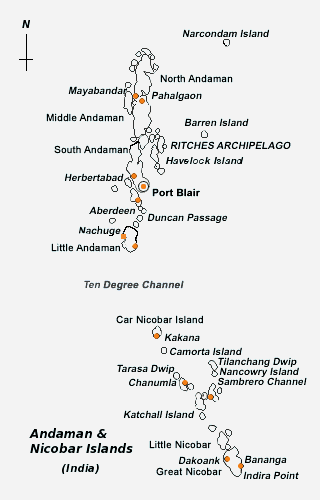
By Aarti Betigeri 21 November 2018
Ecologically fragile
The Andaman and Nicobar Islands are a group of 572 islands, roughly equidistant from both Kolkata and Chennai, about 1,200 kilometres each way to the mainland. Just 37 islands are permanently inhabited, by a mix of indigenous tribes and Indians who moved there after the Second World War. The Nicobar islands have always remained off-limits to outsiders, while only a handful of the Andamans have been open to tourists.

One of the islands’ recognised tribal groups is the Jarawas, sometimes described as the “last descendants of the first modern humans”, still living a largely hunter-gatherer lifestyle. With just a few hundred of them left, the Indian government has long restricted access by outsiders to islands and region, citing their protection. Very little was seen of the Jarawas before a French filmmaking team made a covert – and controversial – documentary about them in 2014.
Until now, the islands have been deliberately under-developed, meaning the islands could retain their unique flora and fauna, and help keep the tribal inhabitants relatively undisturbed. The small-scale tourist scene, predominantly on Havelock Island, mostly sees Indian mainlanders travel down to honeymoon or learn to dive. The islands have, until now, remained perhaps the last bit of India to be relatively untouched and unscathed by the heaving hordes of humanity found elsewhere in Asia.
The islands themselves are considered a global biodiversity hotspot with centuries of relative isolation meaning they contain species found nowhere else in the world. However, the region is ecologically fragile. The 2004 tsunami, apart from leaving thousands of people dead, is believed to have irreversibly altered parts of the marine ecology and killed coral reefs closest to shore.
But it seems the lure of the tourist dollar is just too great. The government has reportedly designated 26 of the islands as having the potential for tourism development, and there are plans afoot to construct 220 resorts, as well as dozens of campsites.
It is a massive U-turn from the government’s previous position and has attracted criticism for the impact it could have on both the environment and tribal populations.
Strategically important
Indian military bases are nothing new for the islands: Port Blair, the capital, has been home to a large base housing air force, naval, and army officers. Car Nicobar, the largest of the Nicobar Islands, has an air force base.
The islands are very strategically located: close to Myanmar and Indonesia, just north of the Malacca Straits, and some of the world’s busiest shipping lanes.
India has been building new, longer airstrips at the top and bottom of the island chain, including one at Campbell Bay on Great Nicobar Island, which opened in 2012. There have also been plans to increase the number of naval vessels stationed on the island.
Currently under consideration is a major transhipment terminal, also at Campbell Bay, which, it is hoped, will help India better conduct trade with south-east Asian nations, along with nine other major projects covering infrastructure, tourism, digital connectivity, healthcare, and education.
But information remains scant – as it always has been, with the Indian government traditionally anxious to limit movement as far as possible. For example, in the aftermath of the tsunami, the only international aid group permitted open access was Unicef; all other foreign NGOs, aid workers, and journalists were barred from travelling beyond Port Blair.
In the absence of information (including decent mobile phone and wifi coverage), rumours flow like coconut toddy across the region, travelling from island to island with the boats. It’s believed that miscreants from Asia – particularly Myanmar and Thailand – like to use the Andamans as a convenient staging post to hide out in the jungle for a bit, then travel to the Indian mainland. Indeed, over the years numerous fishing poachers have been caught. It is also rumoured that drug smugglers, even would-be terrorists, like to stop off in the Andamans en route to Chennai.
But while it’s all they talk of at cafes and roadside stalls, you will rarely read about it in the local papers.
But one rumour, in particular, has recently been verified. It has been confirmed that Prime Minister Narendra Modi will be making his first visit to the Andamans on 30 December this year. The visit underscores the growing importance of the remote territory, meaning it likely won’t remain a secret hideout sanctuary for very long.
